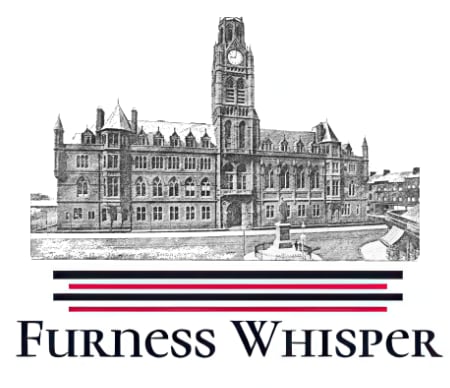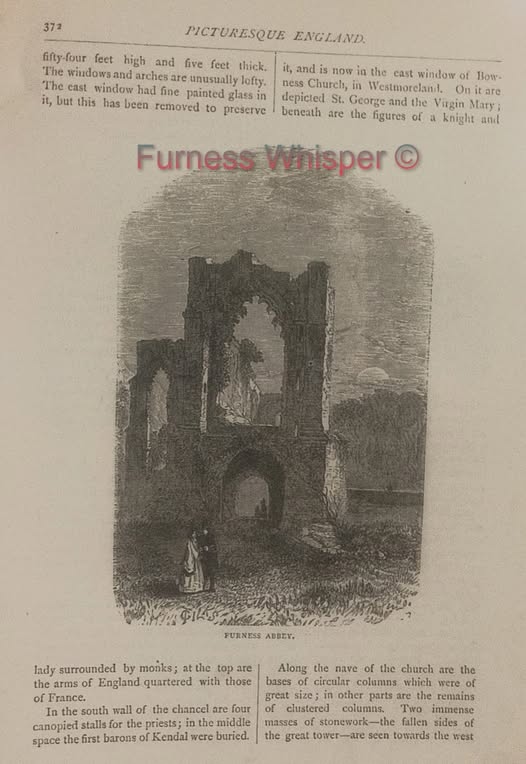Local Historian Gill Jepson Suggests a Wider Search
Imagine standing amidst the haunting ruins of Furness Abbey, the wind whispering through the crumbling arches, the scent of damp earth and ancient stone filling your nostrils. Can you hear the echoes of chanting monks and feel the chill that lingers in the shadows of this once-majestic monastery? Today, our journey takes us beyond these weathered walls, on a quest to uncover a hidden treasure: the abbey’s lost stained glass windows. #FurnessAbbey#HiddenHistory#MedievalMystery
A Promising Lead in Bowness…
Our investigation began with a fascinating discovery: a page from “Picturesque England,” published in 1891, claims the east window of St. Martin’s Church in Bowness-on-Windermere contains stained glass originally from Furness Abbey! Picture this: vibrant hues of ruby, sapphire, and emerald, casting dancing patterns of light across the stone floor as the sun streams through the intricate designs. The page describes the scene depicted on the glass: the noble figure of St. George, alongside the serene image of the Virgin Mary, bathed in celestial blue. Below them, a knight stands in quiet reverence, accompanied by another figure, their identities lost to time. #StainedGlass#ChurchHistory#Bowness
…And a New Possibility in Great Urswick?
We were already aware of the possible connection between St. Martin’s Church and Furness Abbey. But when we consulted with renowned local historian Gill Jepson and showed her the page, she suggested something we hadn’t considered: could a church in Great Urswick also have stained glass from the abbey? Imagine stepping into a dimly lit church, the air heavy with the scent of incense, and finding yourself face-to-face with a window glowing with the rich colours and intricate details of a medieval masterpiece. Gill emphasised that there’s no definitive evidence to confirm the claim about the stained glass in either location, but it’s certainly a possibility worth investigating! #GreatUrswick#LocalHistory#HiddenGems
Why These Locations?
If stained glass from Furness Abbey did find its way to these locations, how did it happen? It’s important to remember that Furness Abbey was a Catholic monastery, while the churches in Bowness and Great Urswick are Church of England. This difference in religious affiliation adds another layer of intrigue to the mystery. Here are a few potential explanations:
Preservation Efforts: Stained glass was incredibly valuable in that period, both for its artistry and the cost of its production. Perhaps the windows were deliberately removed to protect them from damage or destruction during the Dissolution of the Monasteries, when Henry VIII ordered the closure of monasteries and seized their wealth. #HistoryFacts#TudorEngland
Gifts from the Abbey’s New Owners: Could the new owners of Furness Abbey have gifted the windows to churches in the area to gain favour with the local community, despite the religious differences? #ReligiousHistory
Acquired by Wealthy Patrons: Perhaps wealthy individuals purchased the windows and donated them to local churches. #ArtHistory#Patronage
Unravelling the Mystery
This intriguing find, coupled with Gill Jepson’s insightful suggestion, has opened up a new chapter in our exploration of Furness Abbey’s lost treasures. Here’s how we can delve deeper:
Examine the Windows: Let’s take a closer look at the stained glass in St. Martin’s Church and other churches in Great Urswick. Do they match any known examples from Furness Abbey? We might even consult with stained glass experts to analyse the techniques and materials used. Observe the intricate details, the vibrant colours, and the artistry of the figures depicted in the glass. Imagine the skilled hands that crafted these masterpieces centuries ago. #ExploreChurches#StainedGlassArt
Dig into the Archives: Church records, old documents, and local history archives might hold further clues about the acquisition or donation of the windows. Unroll brittle parchments and carefully turn the pages of ancient volumes, searching for any mention of the lost stained glass. #Archives#HistoricalDocuments
Tap into Local Knowledge: Our elders and those with long-standing connections to the churches might possess valuable information passed down through generations. Listen to their stories, whispered in hushed tones, of secret passages and hidden treasures, and let their words paint a vivid picture of the past. #OralHistory#LocalLegends
Insights from a Fellow History Buff
We reached out to our friend and fellow history enthusiast, Kay Thornton, who has extensively researched Sir James Ramsden’s house at Abbots Wood, for her thoughts on this intriguing mystery. Here’s what she had to say:
“To unravel this historical puzzle, I suggest creating a timeline. Start with the earliest date, whether it’s the founding of the churches or the abbey, and mark significant events like new constructions, fires, or the Dissolution. This will help visualise the timeline and determine if it was even possible for the glass to be moved. Remember that churches with existing stained glass windows probably wouldn’t replace them with abbey glass. Perhaps the abbey’s stained glass might be found in a side chapel window, which were often simpler due to cost.”
Two Sides to Every Story
Interestingly, Kay also believes that the stained glass windows were likely destroyed when Henry VIII ordered the dissolution of the monasteries, leading to the destruction of Furness Abbey. This contrasts with the possibility that they were salvaged and relocated. This highlights a fascinating aspect of local history: when definitive evidence is scarce, differing perspectives and interpretations can co-exist, each contributing to a richer understanding of the past. We respect both viewpoints and believe that exploring these different narratives helps paint a more complete picture of our heritage. Perhaps the truth lies somewhere in between, or maybe we’ll “agree to disagree” while continuing to enjoy the mystery!
Join the Quest!
The mystery of Furness Abbey’s stained glass is a captivating reminder of our rich local heritage. Let’s continue this historical quest together and see if we can uncover the full story behind these potential treasures! HistoryHunt #Cumbria #LakeDistrict

